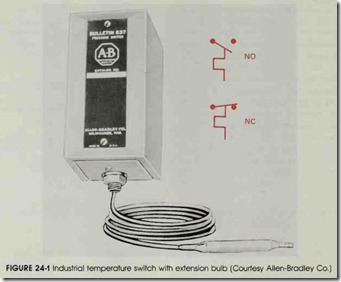Objectives
After studying this unit, the student will be able to:
• Describe the operation of temperature switches
• List several applications of temperature switches
• Read and draw wiring symbols for temperature switches
Temperature switches are designed to provide automatic control of temperature regulating equip ment, figure 24-1. Industrial temperature control lers are used for applications where the tempera ture to be controlled is higher than the normal or ambient temperature. In general, the applications of temperature control are more concerned with the temperature regulation of liquids than of gases. This is a result of the relatively greater con ductivity between the bulb and a liquid, as compared to the conductivity between the bulb and a gas (such as air). Thus, if air or gas temperatures are to be controlled, the sensitivity of the sensor decreases and the difference between the on and off points widens.
To operate a temperature switch, the gas va por or liquid pressure expands a metal bellows against the force of a spring. The expanding bel lows moves an operating pin. The pin snaps a pre cision switch to its operating position when a pre set point is reached. (This action is similar to the operation of industrial pressure switches.) The pressure that operates the switch is proportional to the temperature of a liquid in a closed bulb. The precision switch snaps back to its normal position when the pressure in the bellows drops enough to allow the main spring to compress the bellows.
There are many types of thermostats which can be used to provide automatic control of space heating and cooling equipment. A typical thermo stat is a temperature actuated, two-wire (or more) control pilot device (switch). Temperature-ac tuated switches are used to control circuits in or der to operate heaters, blowers, fans, solenoid valves, pumps, and other devices.
REVIEW QUESTION
1. What are some applications of temperature-actuated switches?
